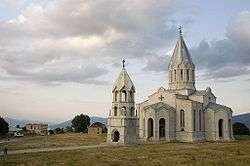Saint Gregory the Illuminator's Church, Baku
| Saint Gregory the Illuminator Cathedral | |
|---|---|
|
The church in April 2013 | |
| Basic information | |
| Location | Corner of Mirza Ibrahimov and Nizami Streets, downtown Baku, Azerbaijan |
| Geographic coordinates | 40°22′18″N 49°50′11″E / 40.371623°N 49.836466°ECoordinates: 40°22′18″N 49°50′11″E / 40.371623°N 49.836466°E |
| Affiliation | Armenian Apostolic Church |
| Ecclesiastical or organizational status | Not functioning |
| Architectural style | Armenian Apostolic Church |
| Groundbreaking | 1863[1] |
| Completed | 1869[1] |
Saint Gregory the Illuminator's Church (Azerbaijani: Müqəddəs Maarifləndirici Qriqori Kilsəsi, Bakı Erməni Kilsəsi, Armenian: Սուրբ Գրիգոր Լուսավորիչ եկեղեցի, Surb Grigor Lusavorich yekeghetsi) is a former Armenian Apostolic church in downtown Baku, Azerbaijan.
History
The church was built between 1863 and 1869.[1] In 1920 the church became the cathedral of the Armenian Apostolic Diocese of Azerbaijan and Turkmenistan.[2] It survived through the Soviet state atheist policies of the 1920s and 1930s when all but two Armenian churches in Baku were destroyed.[2]
With the start of the Nagorno-Karabakh conflict, the Armenian population of Baku was forced to flee. The church was looted on December 25, 1989.[3]
From 1990 until 2002, the church's status remained undetermined. The library of the church consisting of 5,000 books and manuscripts has been preserved.[4]
Serious damaged caused by an arson attack in 1990 was repaired in 2004 during a renovation when the building was taken over by the Presidential Administration of Azerbaijan to be used as one of its libraries. The former church was transformed into the archive department of the Department of Administration Affairs of the Presidential Administration of Azerbaijan.[5]
In April 2010 the church was visited by guests of a World Religious Leaders Summit, including Patriarch Kirill I of Moscow and the head of the Armenian Apostolic Church Karekin II.[6] The Armenian patriarch and the other high-ranking Armenian clerics prayed and chanted medieval hymns while in the church; Karekin II expressed hope that the church would one day reopen for believers.[7]
Gallery
References
- 1 2 3 Stepanyan 2009, p. 47.
- 1 2 Stepanyan 2009, p. 54.
- ↑ Stepanyan 2009, p. 55.
- ↑ The Big Break-Through by Victor Loshak and Emil Guliyev. Ogoniok. #28(5004). 9 July 2007. Retrieved 25 August 2007
- ↑ Yeni Müsavat: "Prezident Kitabxanasının balansında olan məbəddə hələ də təmir gedir; müvafiq qurumlar isə “bu kilsə bərpa olunmayacaq” deyir...". by Günay Musayeva. 5 August 2011 (Azerbaijani)
- ↑ "Гарегин II посетил в Баку армянскую церковь". anspress.com (in Russian). ANS TV. 26 April 2010.
- ↑ Danielyan, Emil (27 April 2010). "Garegin Meets Aliyev, Visits Armenian Church In Baku". azatutyun.am. Radio Free Europe/Radio Liberty.
- Bibliography
- Stepanyan, G. S. (2009). "Համառոտ ակնարկ Բաքվի Սբ. Գրիգոր Լուսավորիչ եկեղեցու պատմության [A Brief Review of the History of St.Gregory the Illuminator Church in Baku]". Lraber Hasarakakan Gitutyunneri (in Armenian) (3): 45–59. ISSN 0320-8117.


.jpg)
